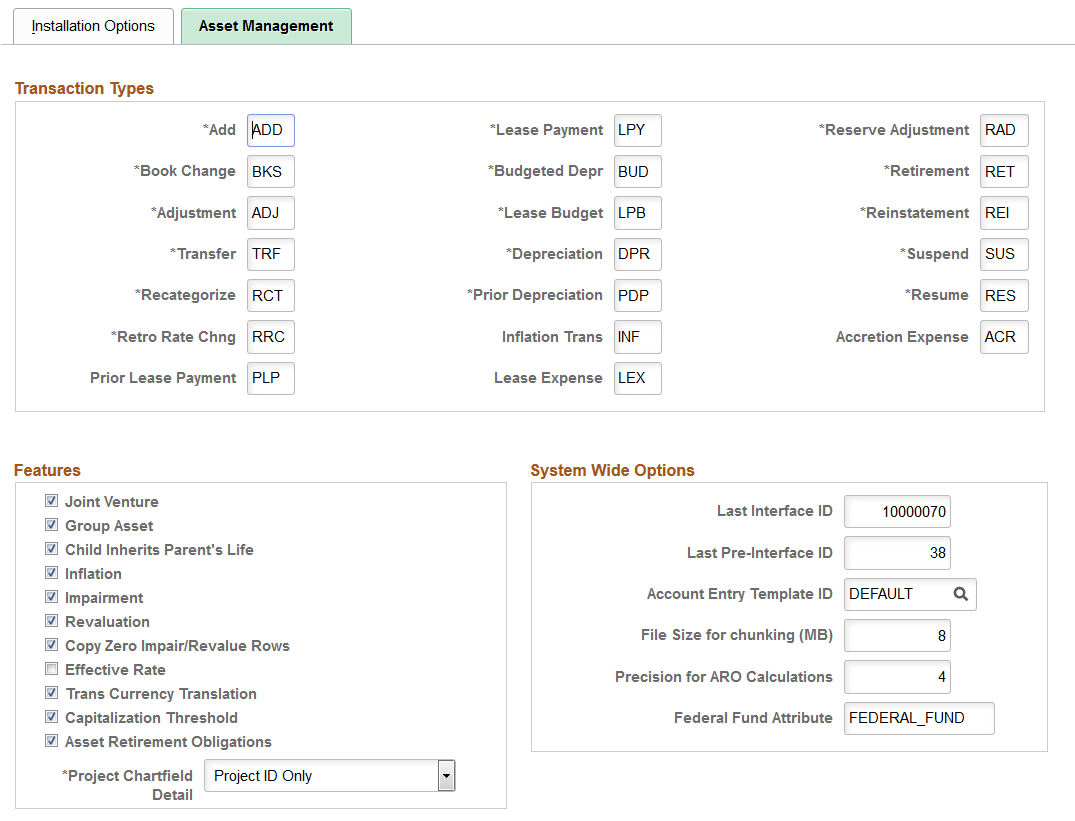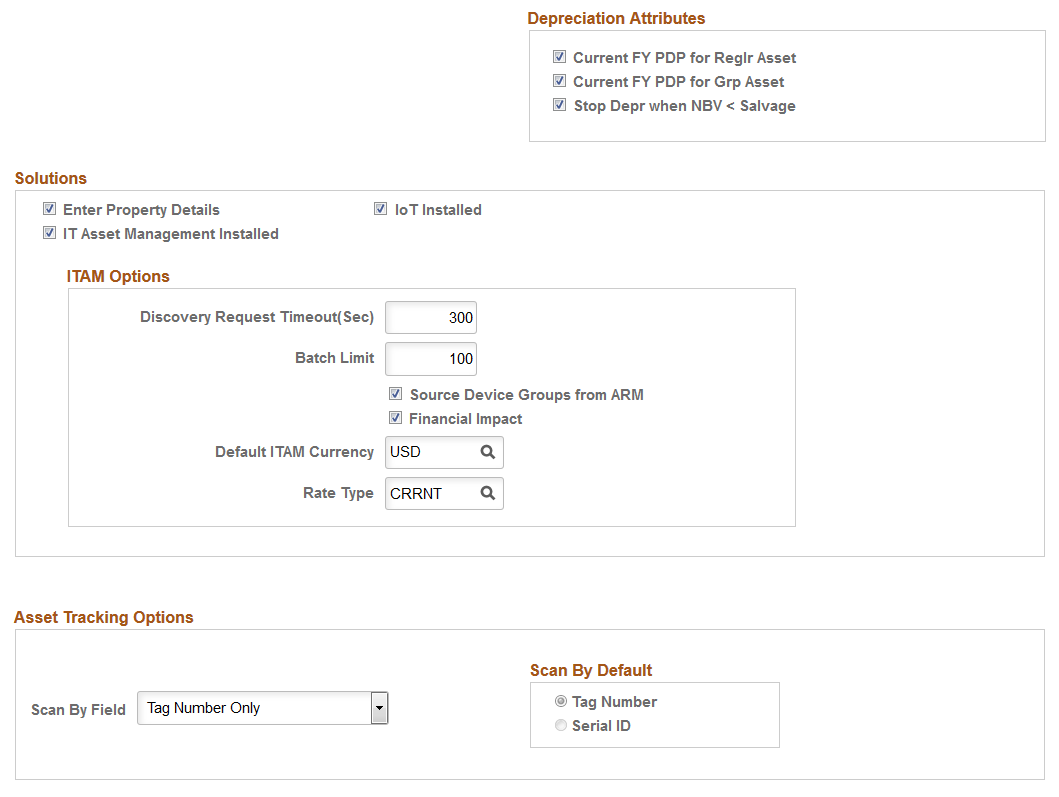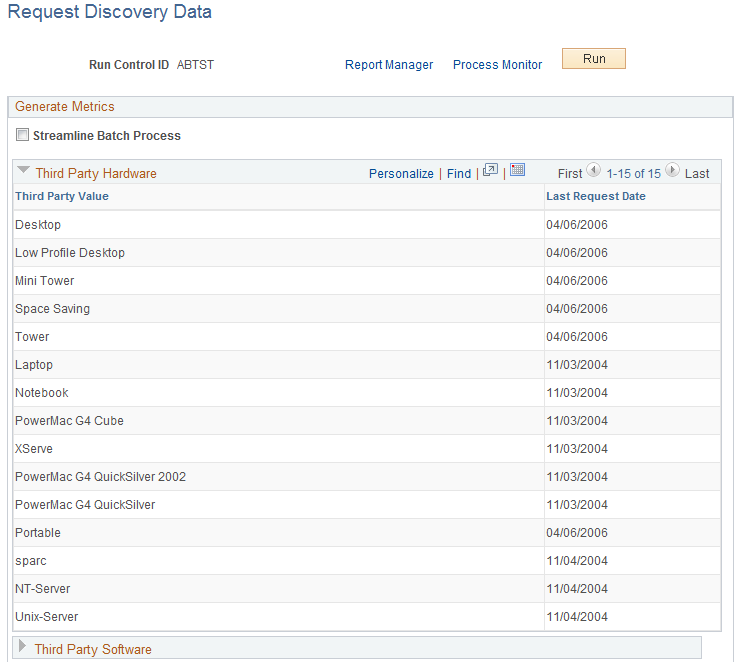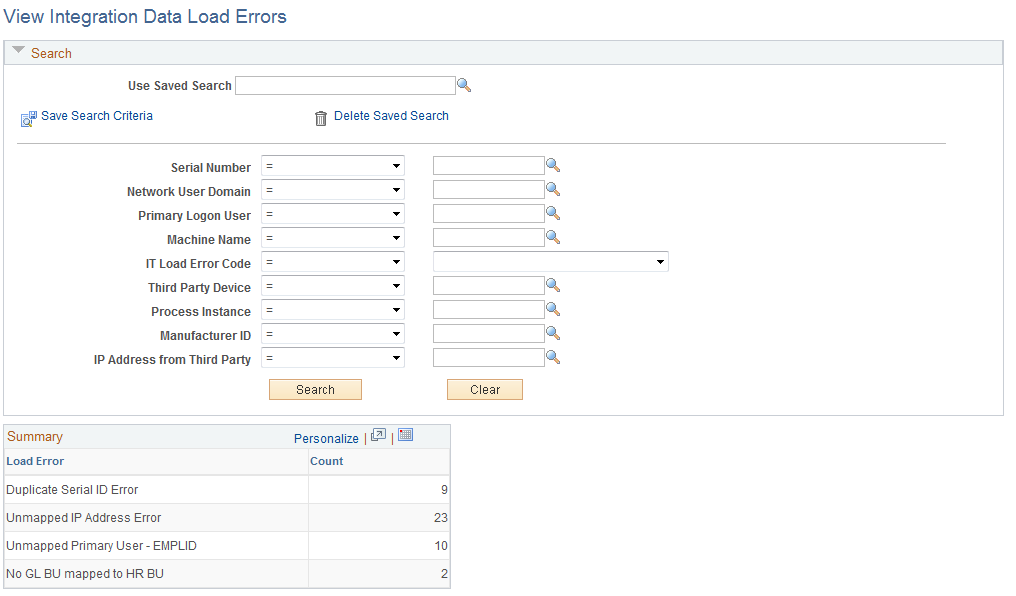Requesting Third Party Inventory Data
This topic discusses how to define PeopleSoft IT Asset Management options for discovery requests. It also discusses how to request discovery data, monitor discovery data requests, and view Integration Data Load Errors.
Use the Request Discovery Data (IT_DISCO_RUN) component to request third-party inventory data.
|
Page Name |
Definition Name |
Usage |
|---|---|---|
|
INSTALLATION_AM |
Define the timeout period for discovery requests. |
|
|
IT_DISCO_RUN |
Set run control options to publish XML requests for inventory data. |
|
|
IT_RQST_STATUS |
View the status of the request made to the third-party application. |
|
|
IT_LOAD_ERRORS |
View the errors produced by the load process for the latest discovery request. |
Use the Installation Options — Asset Management page (INSTALLATION_AM) to define the timeout period for discovery requests.
Navigation:
Click the Asset Management link.
This example illustrates the fields and controls on the Installation Options - Asset Management page 1 of 2. You can find definitions for the fields and controls later on this page.

This example illustrates the fields and controls on the Installation Options - Asset Management page 2 of 2. You can find definitions for the fields and controls later on this page.

See Installation Options - Asset Management Page.
Solutions
Field or Control |
Description |
|---|---|
IT Asset Management Installed |
Select if you have installed IT Asset Management. The ITAM Options group box is displayed. |
Discovery Request Timeout (Sec) |
Enter the number of seconds that processing will wait for a response from a request for inventory data from the third party. This interval applies to both the first response as well as subsequent responses in a single message transaction, in the case where the message contains more than one message file. |
Batch Limit |
Used for Manage Exceptions. |
Source Device Groups from ARM |
This option is used as a default for the Software Device Groups page. Newly created Device Groups will use this as the value for the Source From ARM field. |
Use the Request Discovery Data page (IT_DISCO_RUN) to set run control options to publish XML requests for inventory data.
Navigation:
This example illustrates the fields and controls on the Request Discovery Data page. You can find definitions for the fields and controls later on this page.

Field or Control |
Description |
|---|---|
Streamline Batch Process |
Select to run Compare Asset Repository automatically after the third-party data is processed. If you select Streamline Batch Process, and a Run Control for Compare Asset Repository does not exist, a dialog gives you the choice of having the run controls created automatically or manually. If you choose to create the run controls manually, respond by clicking the Cancel button. This deselects the check box so that you can save the page. You can then navigate to the other Run Control pages to manually create them. Both run control pages can be accessed by using the links at the bottom of the page. When run controls are created automatically for the Compare Asset Repositories and Metrics processes, they are created with same Run Control ID. In the example above, the run controls will be created with Run Control ID of ABC. Conversely, if the user wants to create the run controls manually but wishes to streamline batch processes, the user needs to manually create two run controls with the same Run Control ID. Streamline Batch Process will not be implemented with run controls that have different Run Control IDs. Note: When the Compare Assets process is run, it may also perform actions to correct the exceptions. Business Rules can be defined to automatically execute actions. In this way, the Streamline Batch Process option can truly be a completely automated process without user intervention. |
Third Party Value |
Third Party Hardware displays all IT subtypes that have the Discover/Reconcile flag selected on the IT Subtypes page. Third Party Software displays all software titles with Track Requisition or Permission Required selected on the Define Software Title page. |
Last Request Date |
Displays the date of the last asset inventory data request for each third-party value. |
Compare Asset Repositories Run Control |
Click to view, create, or edit the Compare Asset Repositories run control. |
Metrics Run Control |
Click to view, create, or edit the Metrics run control. |
Note: Remember to check Integration Broker for message details.
Use the View Request Status page (IT_RQST_STATUS) to view the status of the request made to the third-party application.
Navigation:
This example illustrates the fields and controls on the View Request Status page.

The View Request Status page displays the status of requests for inventory data from the third-party system. All fields in the grid are display only.
Use the View Integration Data Load Errors page (IT_LOAD_ERRORS) to view the errors produced by the load process for the latest discovery request.
Navigation:
IT Asset Management, Asset Discovery and Validation, View Integration Data Errors, View Integration Data Load Errors
This example illustrates the fields and controls on the View Integration Data Load Errors page.

The View Integration Data Load Errors page can be accessed directly or from links on the Integration Data Load Errors portal pagelet. This page displays errors detected from the latest successful completion of the ITAM Data Load process (IT_LOAD_PROC Application Engine).